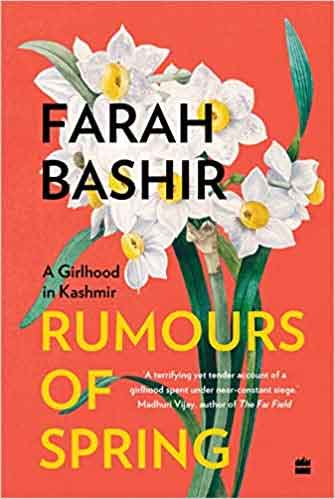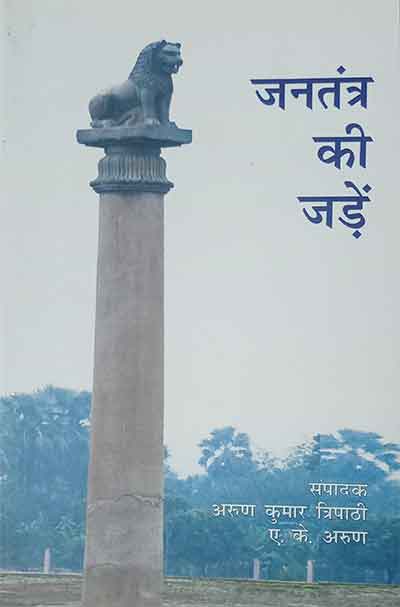The author is growing in disasters. Her journey is sad and strange. Years later, she portrays it in her book Rumours of Spring. The reading of the book is delightful. It comes from the tragedies that are naturally expected in the writings of a woman, if she chooses Kashmir as her subject. Farah Bashir does justice even to those expectations. She gives her readers the shocking tales of mass rapes, the plight of half-widows and the agony of the parents who lost their children. Yet, what adds to the beauty on the pages is the author’s style of presenting the pictures of the disasters, through her lived experience -from her adolescence to her youth. Her childhood gradually emerges as memories, like ours, but the ruins in her memories mark irreversible dents on her life.
 Bashir’s beauty lies in her freedom. Freedom of not constraining her canvas only to the unusual tragedies. She travels to the next level and archives how the lives of ordinary women -housewives, grandmothers, newlyweds next door, the witches and the working women -and that of everyone in Kashmir is suffocated under the boots of militarization. She compares her childhood when there would be no sound of military boot to the violence the military regime unleashed in 1989 and afterwards to repress Kashmiris’ demand for their right to self-determination and plebiscite. Farah Bashir’s coming into age happened at that dangerous period in Srinagar. This book is her memoir of those tumultuous times.
Bashir’s beauty lies in her freedom. Freedom of not constraining her canvas only to the unusual tragedies. She travels to the next level and archives how the lives of ordinary women -housewives, grandmothers, newlyweds next door, the witches and the working women -and that of everyone in Kashmir is suffocated under the boots of militarization. She compares her childhood when there would be no sound of military boot to the violence the military regime unleashed in 1989 and afterwards to repress Kashmiris’ demand for their right to self-determination and plebiscite. Farah Bashir’s coming into age happened at that dangerous period in Srinagar. This book is her memoir of those tumultuous times.
Bashir’s book is not the first account of those tragic incidents. Thousands of newspapers and hundreds of portals and pamphlets have carried these tales. Bashir’s style of adding her experiences to those tales makes the accounts real. It gives the picture in its wholesomeness. Farah Bashir’s tales add reliability even to those unaccounted stories and credibility to the existing ones. She brings in her soul into her words. She challenges the pervasive mechanical way of looking at the daily news about Kashmir. After reading Rumors of Spring, those with a conscience will be able to tell right from wrong, especially when it comes to matters of Kashmir.
People with their right minds will be able to decipher how small things like the author’s adolescent love, her blossoming friendships, her eating habits, her mental health, her relatives’ weddings, and other reminiscences are twisted with the agonizing military presence. They will see through her narration how beautiful evenings are turned into curfews and how the military, if not through its boots, then through its searchlights, invade buildings, including homes -its drawing rooms, kitchen and halls sparing not even the bedrooms.
Farah Bashir’s Rumours of Spring challenges the readers. Her narration of the socio-economic and political lives of Kashmiris -battered by the battalion forces, cornered by cordon and knocks, and tortured by incomprehensive ways -is commanding and gripping. The simple way of life of Kashmiris and their foresighted adjustments to avoid food shortages can be shattered with one search operation. Nothing in their home is theirs. For the protagonist, everything -be it the music system she loves, her exclusive marriage celebration, her favorite walk from the school bus stop to the home -is dictated by an outsider’s invisible hand.
There is every possibility of them being thrown away from their homes and their homes turned into beautifully painted bunkers, or a bunker constructed under their homes. They may remember some tragic incident while eating regular food and lose their appetite forever. They must accustom themselves to sleep with gunshot sounds. Or, with gunshots, sleep forever. Many times, the body of a person is not found, and villagers wait years to offer their funeral prayers.
Kashmiris, like the author herself, may become Post-Traumatic Stress Disorder (PTSD) patients. Farah Bashir’s visual description of such atrocities is powerful. It can be evidently said that there is nothing left for the reader to deny.
After 6 in the evening, all the doors including the windows are closed. Life is dimmed and damned as every home appears as a barrel. A simple smile or a single flash of light could provoke a bullet directly into people’s head and the residents could be classified as a ‘collateral damage’ to the conflict. The two words used by military personnel and carried mechanically by newspapers free them from accountability and the ‘damage’ continues.
The book surprises the readers too, as the author herself is surprised to watch Indian models being advertised in newspapers. It is natural for her to ask, “Don’t they know about crackdowns, curfews, bullet deaths?” How cool are they talking about all this stuff [the advertisement]?” It also has hopelessness. In her farewell letter to her first love, she asks “When you come back, do you believe that curfew will be lifted, and you will be able to meet me?” That question seems to tell us with a scorched voice that those are not love booming times. Does love stand where numerous mistrusts and non-assured feelings are inevitable? After all love needs a base.
Rumors of Spring also bring to light the dark truth of prevailing despair in Kashmir. Addressing the children who are frightened by gunshots and military sirens, the protagonist says, “When we were kids, we were only afraid of the darkness.” Through her child-like innocent expression of feelings, the author, Farah Bashir revealed many harsh facts to the world.
The book also has concerns about saving life. The author rejects her father’s offer to send the books for hard binding. “Who knows, what’s the guarantee that the binding shop will not be set on fire? What if the owner is killed and the shop is permanently closed? What is the guarantee that the shop owner can’t be disappeared forever?” Her thoughts united with these questions may seem pessimistic to an outsider. But they are legitimate doubts considering the time and space in a conflict.
It is sensitive towards the environment. While mourning her grandmother’s, Bobi’s death, the protagonist is content that Bobi had a natural death. But Alas! Her death, too, is not a natural one. The author is thoughtful about elderly women residing at homes, who are getting asthmatic because they inhale the poisonous gases from the tear gas shells enveloping the clean air in Kashmir. Jaji, another character, proves the inevitability of mental illness in Kashmir, which goes beyond 45 per cent of its population according to the NCBI. Like Bobi and Jaji, all the characters in Rumors of Spring are irrefutable proof, standing alive in Kashmir, where every second home has a tragic story.
The book ends. The stories remain. The tragedy continues. The author desires to kiss her death. Though she doesn’t want her body to be mutilated. Neither does she want to rest in mass graves. Like every Kashmiri, the author, too, is longing for an honorable burial.
Rama Sundari is with Progressive Organization for Women. And also an editorial board member of magazine Matruka. She has translated Gowher Geelani’s book Kashmir: Rage and Reason into telugu and edited some of the translated books of kashmiri authors. By profession she is Head of the Electronics and Communications Department in a Government polytechnic, Andhra Pradesh.
















































